Evan Leeper is a third-generation farmer in the US. He farms near Springfield in central Illinois.
When the Irish Farmers Journal visited his farm, he had just finished planting the day before – 19 May. Many crops were up on the farm with maize at six to eight inches in height surrounding the farmyard.
Hay was down, a crop of alfalfa for his father’s Angus cattle. He was starting to bale once we left and expected 500 small squares from 5.5 acres.
The farm is 3,200 acres in size. Maize (or corn, as they call it in the US) and soybeans are the main crops with some wheat, the alfalfa already mentioned and pollinator fields.
The farm runs alongside the interstate and the fields are in open tillage country. It’s vast, but at the same time these big farms are more connected than they seem.
A train passes by the farm as we chat and trucks make themselves heard on the busy interstate road. It may be a big farm, but yet produce is sold locally and transport is near.
Most of the produce on the farm is sold to ADM. The global company has a huge plant in nearby Decatur which we visited.

Soybeans on the Leeper farm.
In that plant sits the biggest wet mill for maize in the world. Some 17,000t move through that plant daily for crushing and extraction for products such as ethanol, corn distillers, corn gluten pellets and many more.
Yields and fertiliser
Evan explained that nitrogen (N) use efficiency is good on the farm because they are producing high-yielding crops. The corn had just been side-dressed when we were there.
The fertiliser is placed in the ground at the side of the row of corn. Corn on the farm is yielding about 245 bushels per acre (8.6t/ac) on about 180 units of N, which is a mixture of liquid and solid fertiliser and is applied in the autumn, to the seed bed and after sowing.
Establishment was 90% this year. The crop was planted on 15 April and will be harvested at the end of September.
Soybeans are sown with a 24-row planter that covers 75ac per fill. Soybeans generally yield over 80 bushels per acre (2.8t/ac) on the farm.
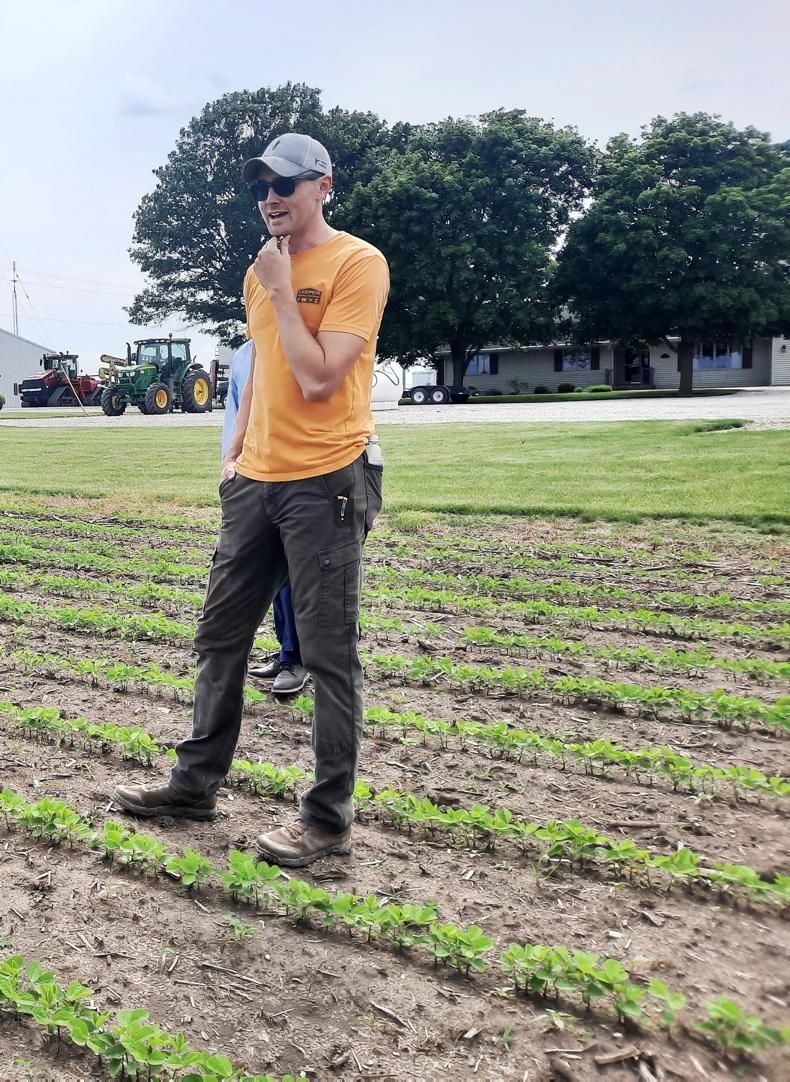
Evan Leeper on his farm in Illinois.
A total of 110ac of wheat are grown on the farm and this travels to Paris, Illinois or St Louis, Missouri.
Storing grain
Evan’s ADM account manager was on the farm. Charlotte was trying to get him to move some old crop.
The Leepers built a new grain silo two years ago, which holds 30,000 bushels. More and more farmers are storing more grain on their farms.
The farmers want more power to hold on to the grain.
The traders are saying it is affecting their markets.
It is unusual for Evan to still have old crop at this time of the year, but he is clearly frustrated at the markets. That day, 20 May, they took a huge bump.
He outlined his frustrations at speculators trading positions who don’t have any grain.
Back in the field, Evan pointed out a weed – waterhemp. It is problematic but the GM soybeans allow it to be controlled with glyphosate and 2-4D. Those soybeans also have a seed treatment, which allows them to be planted earlier.
Evan’s grandfather traditionally planted soybeans on 10 May, but some of the soybeans were up a long time when we visited and all planting was completed by 19 May.
GM crops have offered drought tolerant traits, earlier sowing, weed control and one thing that stands out is that he doesn’t apply insecticides.
At the same time back home, Irish farmers were spraying pyrethroids to target aphids and prevent barley yellow dwarf virus.
Large levels of BYDV were still seen in many crops and the spray could kill natural predators. It is clear to see that GM offers an advantage in that matter.
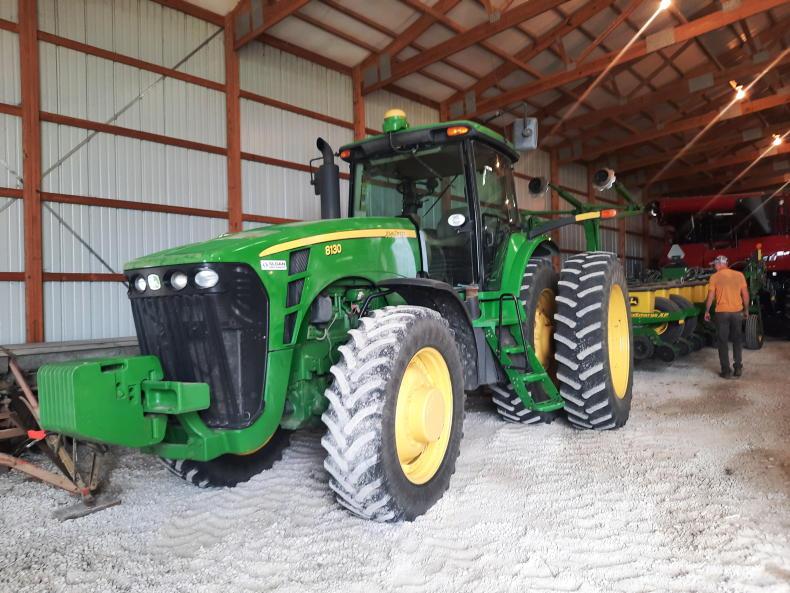
There are two planters on the farm.
GM is a whole other debate. Yes, GM has helped to reduce pesticide use, but there are advantages to Ireland not having GM crops as well.
American agriculture is becoming greener. It’s definitely not at the same pace as Europe.
The farmers or the policymakers are not willing to sacrifice lower production or take large areas of good land out of intense production.
In the US Midwest, we were seeing some of the best crop-growing areas of the country and it simply wasn’t on their radar to move to organic or reduce production on land that can produce high yields. However, consumer sentiment is changing.
They are willing to pay more for more sustainable food and this is something that ADM has taken note of.
It may not be tomorrow or the next day, but the thinking is that in the coming years consumers will pay for a sustainability logo on their food.
The company has started a regenerative agriculture programme and unlike some of the programmes that we see launched in Ireland, it is paying farmers. Very importantly, the focus is still on food production.
Sustainable food production does not need to mean reducing yield or taking land out of production. Those payments are at different rates and scales in regions and for different actions and crops, but as an example, a farmer in Illinois will be paid $10/ac to $25/ac to plant a cover crop.
Evan planted his cover crop with an airplane that flew over the soybean crop before harvest, so the seed is growing before the crop is harvested.
Cover crops need to be in by 1 September to establish well in Evan’s area. He has grown oats, rye, radish and, this year, sunflowers are on his list.
Farmers also get paid for using low-disturbance tillage, for growing a break crop and other measures, but the focus is on maintaining food production.

Corn after being side-dressed with nitrogen, the cut in the soil is visible where fertiliser was applied.
Jenny Poling, who is in charge of recruiting farmers to the programme, said that it can be hard to sign people up, but what is helping is data.
A smaller pilot of the project allowed ADM to show farmers the benefits of cover crops, for example. This year, many of them are very happy because the cover crops they planted allowed them to get into wet ground earlier. The soil had improved. In a wet spring, the living roots of the cover crops kept moisture levels under control and made it easier to work the soil.
The frost often looks after cover crop destruction as well as it kills the plants, and a herbicide may not need to be applied, so this is a saving on inputs.
Jenny added that farmers can be paid for minimum tillage practices, keeping living roots in the soil, logging their data and benchmarking.
While the data has helped to sign people up to the programme, it was also a reason some were slow to sign up as they were cautious of sharing data. However, all the data collected stays with the farmer and the project.
It is also worth noting that it only takes about 45 minutes to collect the data throughout the year as ADM uses other systems and plugs into data already collected on the farm.
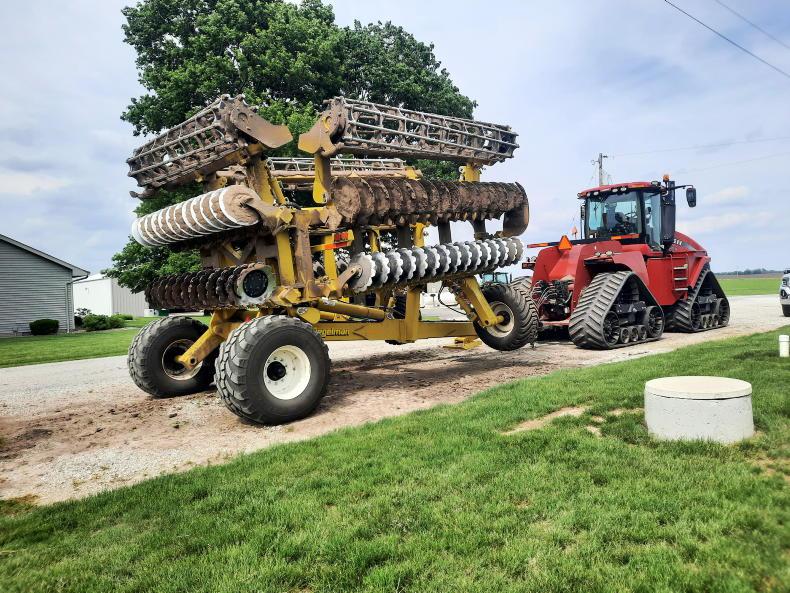
This disc is 36ft wide and travels at about 15km/hour. It can till from one to seven inches. The Leepers operate at around three inches.
This data is, of course, essential in selling product. It can’t be marked as sustainably produced if there is no data to back it up. Soil tests, soil carbon samples, crop inputs and yields are all needed to calculate emissions and to calculate carbon storage potential on the farm.

The older grain bin on the Leeper farm.
Pollinator fields are planted as part of the US Department of Agriculture’s Conservation Reserve programme. Evan has 27ac in the measure, which is planted in grasses and flowers and can be mowed after 1 August. The average payment to farmers in this programme, implementing these set-a-side measures is $78.20/ac (€71.76/ac).
Evan is focused on producing high-yielding crops.GM has helped him to cut inputs and reduced problems with pests.ADM is paying Evan to take part in a regenerative agriculture programme.Benefits can be seen to the soils on his farm.
Corn on the Leeper farm.
Evan Leeper is a third-generation farmer in the US. He farms near Springfield in central Illinois.
When the Irish Farmers Journal visited his farm, he had just finished planting the day before – 19 May. Many crops were up on the farm with maize at six to eight inches in height surrounding the farmyard.
Hay was down, a crop of alfalfa for his father’s Angus cattle. He was starting to bale once we left and expected 500 small squares from 5.5 acres.
The farm is 3,200 acres in size. Maize (or corn, as they call it in the US) and soybeans are the main crops with some wheat, the alfalfa already mentioned and pollinator fields.
The farm runs alongside the interstate and the fields are in open tillage country. It’s vast, but at the same time these big farms are more connected than they seem.
A train passes by the farm as we chat and trucks make themselves heard on the busy interstate road. It may be a big farm, but yet produce is sold locally and transport is near.
Most of the produce on the farm is sold to ADM. The global company has a huge plant in nearby Decatur which we visited.

Soybeans on the Leeper farm.
In that plant sits the biggest wet mill for maize in the world. Some 17,000t move through that plant daily for crushing and extraction for products such as ethanol, corn distillers, corn gluten pellets and many more.
Yields and fertiliser
Evan explained that nitrogen (N) use efficiency is good on the farm because they are producing high-yielding crops. The corn had just been side-dressed when we were there.
The fertiliser is placed in the ground at the side of the row of corn. Corn on the farm is yielding about 245 bushels per acre (8.6t/ac) on about 180 units of N, which is a mixture of liquid and solid fertiliser and is applied in the autumn, to the seed bed and after sowing.
Establishment was 90% this year. The crop was planted on 15 April and will be harvested at the end of September.
Soybeans are sown with a 24-row planter that covers 75ac per fill. Soybeans generally yield over 80 bushels per acre (2.8t/ac) on the farm.

Evan Leeper on his farm in Illinois.
A total of 110ac of wheat are grown on the farm and this travels to Paris, Illinois or St Louis, Missouri.
Storing grain
Evan’s ADM account manager was on the farm. Charlotte was trying to get him to move some old crop.
The Leepers built a new grain silo two years ago, which holds 30,000 bushels. More and more farmers are storing more grain on their farms.
The farmers want more power to hold on to the grain.
The traders are saying it is affecting their markets.
It is unusual for Evan to still have old crop at this time of the year, but he is clearly frustrated at the markets. That day, 20 May, they took a huge bump.
He outlined his frustrations at speculators trading positions who don’t have any grain.
Back in the field, Evan pointed out a weed – waterhemp. It is problematic but the GM soybeans allow it to be controlled with glyphosate and 2-4D. Those soybeans also have a seed treatment, which allows them to be planted earlier.
Evan’s grandfather traditionally planted soybeans on 10 May, but some of the soybeans were up a long time when we visited and all planting was completed by 19 May.
GM crops have offered drought tolerant traits, earlier sowing, weed control and one thing that stands out is that he doesn’t apply insecticides.
At the same time back home, Irish farmers were spraying pyrethroids to target aphids and prevent barley yellow dwarf virus.
Large levels of BYDV were still seen in many crops and the spray could kill natural predators. It is clear to see that GM offers an advantage in that matter.

There are two planters on the farm.
GM is a whole other debate. Yes, GM has helped to reduce pesticide use, but there are advantages to Ireland not having GM crops as well.
American agriculture is becoming greener. It’s definitely not at the same pace as Europe.
The farmers or the policymakers are not willing to sacrifice lower production or take large areas of good land out of intense production.
In the US Midwest, we were seeing some of the best crop-growing areas of the country and it simply wasn’t on their radar to move to organic or reduce production on land that can produce high yields. However, consumer sentiment is changing.
They are willing to pay more for more sustainable food and this is something that ADM has taken note of.
It may not be tomorrow or the next day, but the thinking is that in the coming years consumers will pay for a sustainability logo on their food.
The company has started a regenerative agriculture programme and unlike some of the programmes that we see launched in Ireland, it is paying farmers. Very importantly, the focus is still on food production.
Sustainable food production does not need to mean reducing yield or taking land out of production. Those payments are at different rates and scales in regions and for different actions and crops, but as an example, a farmer in Illinois will be paid $10/ac to $25/ac to plant a cover crop.
Evan planted his cover crop with an airplane that flew over the soybean crop before harvest, so the seed is growing before the crop is harvested.
Cover crops need to be in by 1 September to establish well in Evan’s area. He has grown oats, rye, radish and, this year, sunflowers are on his list.
Farmers also get paid for using low-disturbance tillage, for growing a break crop and other measures, but the focus is on maintaining food production.

Corn after being side-dressed with nitrogen, the cut in the soil is visible where fertiliser was applied.
Jenny Poling, who is in charge of recruiting farmers to the programme, said that it can be hard to sign people up, but what is helping is data.
A smaller pilot of the project allowed ADM to show farmers the benefits of cover crops, for example. This year, many of them are very happy because the cover crops they planted allowed them to get into wet ground earlier. The soil had improved. In a wet spring, the living roots of the cover crops kept moisture levels under control and made it easier to work the soil.
The frost often looks after cover crop destruction as well as it kills the plants, and a herbicide may not need to be applied, so this is a saving on inputs.
Jenny added that farmers can be paid for minimum tillage practices, keeping living roots in the soil, logging their data and benchmarking.
While the data has helped to sign people up to the programme, it was also a reason some were slow to sign up as they were cautious of sharing data. However, all the data collected stays with the farmer and the project.
It is also worth noting that it only takes about 45 minutes to collect the data throughout the year as ADM uses other systems and plugs into data already collected on the farm.

This disc is 36ft wide and travels at about 15km/hour. It can till from one to seven inches. The Leepers operate at around three inches.
This data is, of course, essential in selling product. It can’t be marked as sustainably produced if there is no data to back it up. Soil tests, soil carbon samples, crop inputs and yields are all needed to calculate emissions and to calculate carbon storage potential on the farm.

The older grain bin on the Leeper farm.
Pollinator fields are planted as part of the US Department of Agriculture’s Conservation Reserve programme. Evan has 27ac in the measure, which is planted in grasses and flowers and can be mowed after 1 August. The average payment to farmers in this programme, implementing these set-a-side measures is $78.20/ac (€71.76/ac).
Evan is focused on producing high-yielding crops.GM has helped him to cut inputs and reduced problems with pests.ADM is paying Evan to take part in a regenerative agriculture programme.Benefits can be seen to the soils on his farm.
Corn on the Leeper farm.












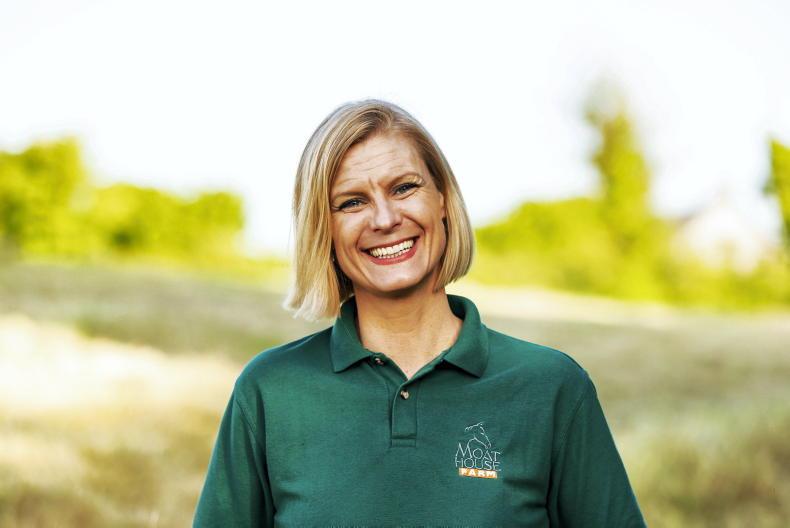
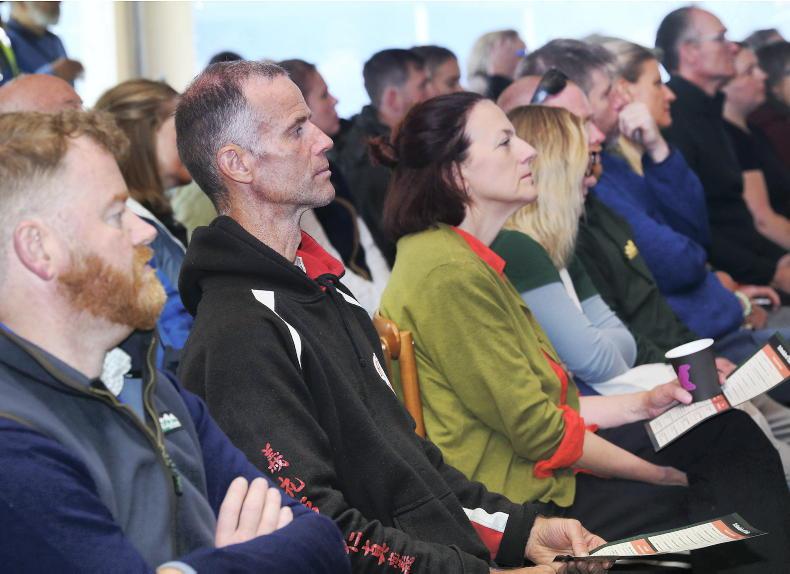
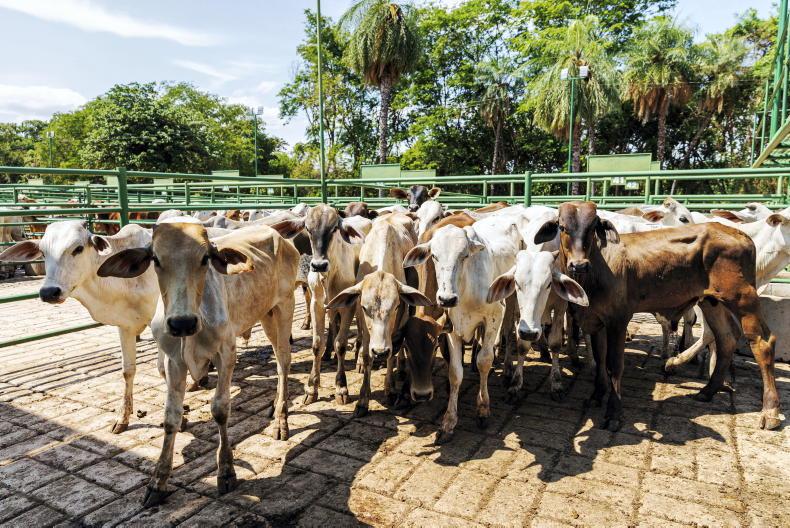

SHARING OPTIONS